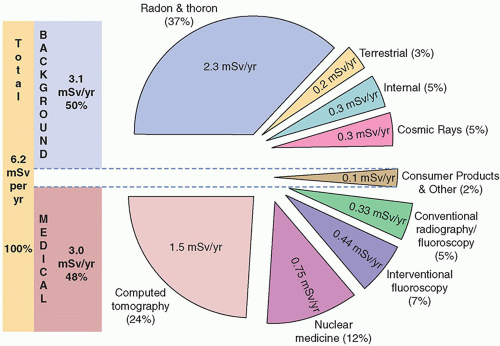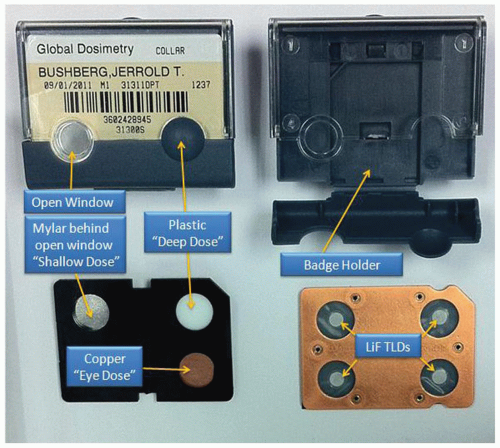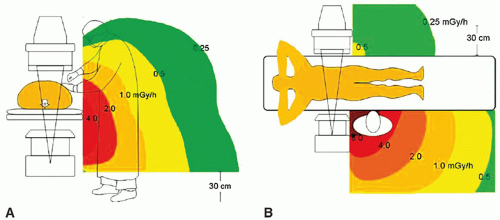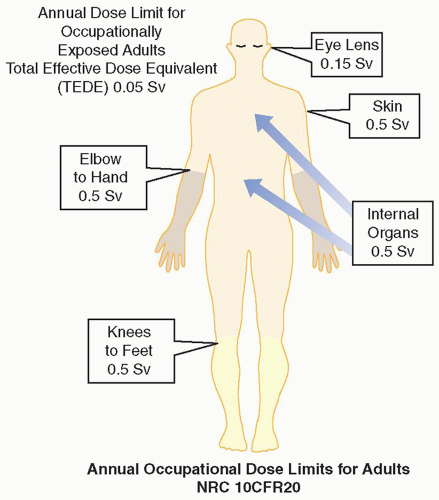Radiation Protection
21.0 INTRODUCTION
It is incumbent upon all individuals who use radiation in medicine to strive for an optimal compromise between its clinical utility and the radiation doses to patients, staff, and the public. Federal and state governments and even some large municipalities have agencies that promulgate regulations regarding the safe use of radiation and radioactive material. Radiation protection programs are designed and implemented to ensure compliance with these regulations. Radiation protection programs include the development of procedures for the safe use of radiation and radioactive material and education of staff about radiation safety principles as well as the risks associated with radiation exposure and contamination.
21.1 SOURCES OF EXPOSURE TO IONIZING RADIATION
1. The average annual per capita effective dose from exposure to ionizing radiation in the United States is about 6.2 mSv (about 17 µSv per day).
2. Half of the total (3.0 mSv) is from medical exposure of patients, which has increased almost a factor of 6 since the 1080s (Fig. 21-1). The other half (3.1 mSv) is from naturally occurring sources (cosmic rays, cosmogenic radionuclides, and primordial radionuclides and their progeny) (Fig. 21-2).
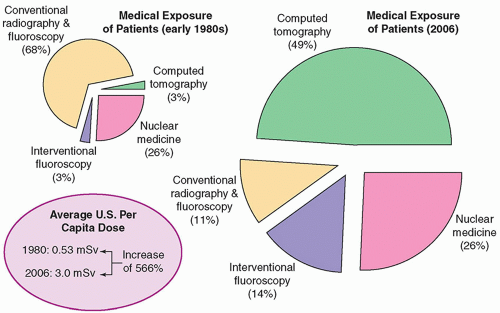
▪ FIGURE 21-1 Average annual per capita effective doses in the United States from medical imaging procedures, showing the large increase from 1980 to 2006.
3. Consumer products, nuclear power, and fallout from atomic weapons cause only a small fraction of the average population exposure to radiation.
4. Radiation from radon exposure (222Rn and progeny) in the United States contributes the greatest effective dose (2.1 mSv) from naturally occurring sources.
5. By 2016 about a 15% to 20% reduction in medical imaging dose had been achieved due to advances in technology, awareness of dose, and optimization of patient doses per procedure.
21.2 PERSONNEL DOSIMETRY
1. Personnel radiation exposures are typically monitored by dosimeters using storage phosphors (e.g., TLDs or OSLs) that store energy in trapped electrons. Following the exposure period (typically monthly), the dosimeters are processed (“read”) by exposing the phosphors to heat (TLD) or laser energy (OSL). The light emitted from the dosimeter is proportional to the absorbed dose. These phosphor-based dosimeters have largely replaced the older film badge dosimeters for which radiation exposure causes darkening of the film emulsion, which is proportional to the absorbed dose.
a. TLDs: thermoluminescent dosimeters (Fig. 21-3)
b. OSLs: optically stimulated luminescent dosimeters
2. Dosimeters are typically provided by a commercial vendor monthly or quarterly with reports listing shallow (skin), eye (lens), and deep (whole-body dose corresponding to penetrating radiations) dose.
3. For radiologists, x-ray technologists, and nuclear medicine technologists, dosimeters are typically worn at waist or shirt-pocket level.
4. For fluoroscopy and interventional procedures, dosimeters are typically placed at collar level in front of the lead apron (and sometimes a second badge is worn under the apron). Effective doses are assessed using algorithms based on the worn badges.
5. A pregnant radiation worker typically wears an additional dosimeter at waist level to assess the fetal dose.
6. Electronic (or self-reading) personal dosimeters with associated alarm functions are supplemental dosimeters that can be used for dose feedback when high doses are expected (e.g., cardiac catheterization or high-dose nuclear medicine therapies).
21.3 RADIATION DETECTION EQUIPMENT IN RADIATION SAFETY
1. GM (Geiger-Mueller) survey meters detect the presence and provide an indication of intensities of radiation contamination and fields in units of counts per minute (cpm). GM survey meters can also be properly calibrated for energy and response to provide estimates of exposure rate (mR/h).
2. GM survey meters are useful for locating radioactive material and/or contamination following the use of unsealed radioactive materials (e.g., nuclear medicine or radiopharmacy labs).
3. Ionization chamber survey meters provide accurate measurements of radiation exposure rate (see Chapter 17) and approximate the conditions under which the roentgen is defined (see Chapter 3).
4. Ionization chambers are useful for monitoring dose rates near radiation generating equipment and near patients who have received radioactive material administrations.
21.4 FUNDAMENTAL PRINCIPLES AND METHODS OF EXPOSURE CONTROL
1. Three key radiation protection principles: justification, optimization, and limitation of maximum doses.
a. Justification: benefit of radiation use is higher than the detriment it causes.
b. Optimization: keeping exposures as low as reasonably achievable (ALARA), implying the lowest dose necessary to produce diagnostic quality. This concept has also been referred to as ALADA, as low as diagnostically acceptable.
c. Limitation of maximum doses: for planned situations, regulatory limits on maximal doses for workers and members of the public. Not applicable to medical exposure of patients and emergency situations.
2. The American College of Radiology (ACR) promulgates appropriate use criteria as evidenced-based guidelines for justification.
3. Methods of exposure control include time (reducing), distance (increasing), shielding (using when appropriate), and controlling contamination.
21.5 STRUCTURAL SHIELDING OF IMAGING FACILITIES
1. Shielding design goals, P, are stated in terms of K (mGy) at a reference point beyond a protective barrier (e.g., 0.3 m for a wall) delivered over a specified time interval (e.g., weekly, annually). Shielding methods for diagnostic and interventional x-ray rooms are provided in NCRP Report No. 147.
2. A controlled area is an area to which access is controlled for the purposes of radiation protection (procedure rooms, control booths), which under specified exposure conditions is designed not to exceed 0.1 mGy/wk.
3. Uncontrolled areas are other areas (offices, adjacent rooms, hallways, etc.), which under specified exposure conditions are designed not to exceed 0.02 mGy/wk.
4. Exposure sources include primary, scattered, and leakage radiation.
5. The amount of primary radiation depends on the output of the x-ray tube (kV, mGy/min, and mAs) per examination, no. of examinations/week, the fraction of time beam is pointed at a specific barrier (U, use factor), and distance to that barrier.
6. Scattered radiation at 1 m from a patient is about 0.1% to 0.15% of the incident exposure to the patient.
7. Lead is the most commonly used material for shielding x-ray facilities (high attenuation and low cost), although gypsum, concrete, glass, and leaded glass are also utilized.
8. Occupancy factor (T) represents the average fraction of the time maximally exposed individual is present while x-ray beam is on. Workload (W) is the time integral of the x-ray tube current over 1 week (mA-min/wk).
9. In most PET/CT installations, the thick shielding for the annihilation photons is more than sufficient for the lower-energy secondary radiation from the x-ray CT system.
10. Radiologists should obtain the assistance of a qualified medical physicist for the design of shielding.
21.6 RADIATION PROTECTION IN DIAGNOSTIC AND INTERVENTIONAL X-RAY IMAGING
1. Protective aprons and collar shields, usually of 0.25- to 0.50-mm lead, protect the torso and thyroid and attenuate greater than 90% of the scattered radiation for fluoroscopy, interventional, and CT-guided procedures.
2. In fluoroscopy, the stray radiation intensity is higher on the side of the patient toward the x-ray source than on the side toward the image receptor (Fig. 21-4).
a. Keep the x-ray tube under the patient whenever able.
b. Ceiling mounted, table-mounted, and mobile radiation barriers can reduce operator doses, as can the use of leaded glasses to reduce lens of eye dose.
3. No pregnant or less than 18-year-old individuals should routinely hold patients during examinations.
4. An important goal in diagnostic imaging is to achieve an optimal balance between image quality and dose to the patient.
a. Patient exposure can often be reduced by using higher kV and lower mAs.
b. In CT angiography, greater beam filtration and lower kV can improve contrast-to-noise ratio and thus lower dose.
c. Collimate field size to just necessary volume. Consider shielding other organs (or limbs) when the shadow of the shield does not interfere with anatomy under investigation.
d. Do not use patient shielding in CT as it interferes with auto-exposure control and introduces artifacts.
5. Fluoroscopy imparts some of the largest imaging tissue doses to individual patients. Patient entrance air kerma is limited to a maximum of 87.3 mGy/min (with auto brightness control) and 44 mGy/min without. The cumulative skin doses in difficult cases or from a series of procedures of a single area of the body can exceed 10 Gy, which can lead to severe radiation-induced skin injuries. Physicians using or directing use should be trained and credentialed.
6. Patient organ doses from CT imaging are typically on the order of 10s of mGy and depend on kV, mA, time per x-ray tube rotation, detector-table motion pitch, and beam filter. Careful protocol settings are necessary (see Chapter 10).
7. Dose optimization, such as automatic exposure control, and right-sizing per patient can result in lower doses and should be considered, especially for thinner patients and pediatrics.
8. National or regional diagnostic reference levels (DRLs, typically 75th percentile) and achievable doses (ADs, typically 50th percentile) can be used to evaluate individual site dose optimization.
21.7 RADIATION PROTECTION IN NUCLEAR MEDICINE
1. Minimizing time, maximizing distance, and utilizing shielding when appropriate are important.
2. The use of syringe shields can reduce hand exposure for Tc-99m by as much as 100 fold.
3. Lead aprons utilized in diagnostic radiology are of limited value in the higher-energy photons from radiopharmaceuticals used in nuclear medicine.
4. PET facilities often require shielding (typically lead) of barriers to surrounding areas to attenuate the 511-keV annihilation radiation.
5. Proper contamination control (periodic GM surveys and wipe tests) and lab safety practices (labeling, coats, gloves, goggles, survey hands and clothing, dosimetry, waste disposal, shields where appropriate, no eating/drinking/smoking, etc.) are essential radiation protection methods.
6. Control ordering, receipt, and shipping (per DOT rules) for nuclear medicine.
7. S.W.I.M. for spills—Stop the spill, Warn others, Isolate the area, and Mitigate (cleanup from outside in).
8. Take care with patient identification and double-check prescribed compounds, quantities, and route of administration to prevent medical events.
9. Complete cessation of breastfeeding is suggested for Ga-67 citrate and I-131. Consult available tables and guidance for other radiopharmaceuticals.
10. Consider radiation precautions and instructions per regulations for radionuclide therapy patients.
11. Guidance on the release of patients is found in NCRP Report 155 and ensures doses do not exceed 5 mSv for careers or 1 mSv for members of the public.
21.8 REGULATORY AGENCIES AND RADIATION EXPOSURE LIMITS
1. Several regulatory agencies have jurisdiction over various aspects of the use of radiation in medicine. Regulations under their authority carry the force of law.
2. The U.S. Nuclear Regulatory Commission (NRC) regulates special nuclear material (plutonium and uranium enriched in U-233 and U-235), source material (thorium, uranium, and their ores), and by-product material used in nuclear power, research, medicine, and other commercial activities.
3. “Agreement States” have entered into agreements with the NRC to promulgate and enforce regulations similar to those of the NRC. In addition, the agencies of the agreement states typically regulate all sources of ionizing radiation, including diagnostic and interventional x-ray machines and linear accelerators used in radiation oncology.
4. Medical workers must be informed of their rights and responsibilities, including the risks inherent in utilizing radiation sources and their responsibility to follow established safety procedures.
5. NRC regulations are found in Title 10 (Energy) of the Code of Federal Regulations (CFR). Part 20, “Standards for Protection against Radiation” and Part 35, “Medical Use of Byproduct Material” are essential sections of the code for medical staff.
a. By-product material: In the Atomic Energy Act of 1954, the term by-product material referred primarily to radioactive by-products of nuclear fission in nuclear reactors (fission products and activation products). The Energy Policy Act of 2005 expanded the definition of by-product material to include material made radioactive by use of a particle accelerator. As such, most radiopharmaceuticals are now subject to NRC regulation.
6. Part 20 specifies the maximal permissible doses to radiation workers and the public among other radiation safety program essential elements.
7. Part 35 includes medical use categories, training requirements, precautions, testing and use of dose calibrators, and requirements for the reporting of medical events involving the use of radiopharmaceuticals and radiation.
8. NRC and Agreement State regulatory guidance documents provide acceptable methods for satisfying the regulations and are thus important sources of practical implementation policies and procedures for medical facilities.
9. Other regulatory agencies involved in the use of radiation and radioactive material in medicine include the Food and Drug Agency (FDA), the U.S. Department of Transportation (USDOT), the U.S. Department of Labor (OSHA), the U.S. Office of Human Research Protection (OHRP), and the U.S. Environmental Protection Agency (EPA).
10. Often, x-ray regulations are promulgated at the state level (with additional rules on mammography coming from the FDA) and several states specifically designate definitions of Qualified Medical Physicists.
11. The National Council on Radiation Protection and Measurements (NCRP) and the International Commission on Radiological Protection (ICRP) are recognized professional advisory bodies on radiation, including its use in medicine. The International Atomic Energy Agency (IAEA) provides guidance on the implementation of ICRP recommendations. The United Nations Scientific Committee on the Effects of Atomic Radiation (UNSCEAR) assesses global levels and evaluates the short- and long-term biological effects of ionizing radiation.
12. Other important professional societies develop practical-specific recommendations and guidance in the area of radiation protection of patients and staff that should be consulted by practicing medical physicists, for example, American Association of Physicists in Medicine (AAPM), ACR, Radiological Society of North America (RSNA), Society of Nuclear Medicine and Molecular Imaging (SNMMI), and Health Physics Society (HPS). Ongoing collaborative associations with equipment vendors are also important contributors, for example, Medical Imaging & Technology Alliance (MITA), National Electrical Manufacturer’s Association (NEMA), and the International Electrotechnical Commission (IEC).
13. NRC and Agreement State regulations regulate that doses to individuals shall not exceed established limits (Fig. 21-5) and that all exposures shall be kept ALARA, social and economic factors being taken into account.
21.9 PREVENTION OF ERRORS
1. A goal of radiation protection programs is to reduce the likelihood and severity of accidents involving radiation and radioactive materials.
a. Safety culture: represents a set of attributes of an organization, such as a radiology or nuclear medicine department, that are believed to reduce the likelihood of errors; and the behavior and practices resulting from a commitment by leaders and individuals to emphasize safety over competing goals to protect patients, staff, and the public.
2. Policies and procedures may incorporate the following:
a. The use of a “time out” in which the staff about to perform a clinical procedure jointly verify that the intended procedure is to be properly performed on the intended patient
b. The use of written or computerized checklists to ensure that essential actions are not omitted
c. Checks of critical tasks by a second person
d. Requiring that certain critical communications be in writing
e. Employing readback in verbal communications, whereby the person hearing information repeats it aloud
f. Measures to avoid distractions and interruptions during critical tasks, such as prohibiting unnecessary conversations unrelated to a task
3. The incorporation of engineered safety features, such as interlocks that prevent unsafe actions, and automated checks, such as the dose notifications and alerts provided by newer CT scanners, help to avoid accidents due to human errors.
4. When an error or a “near-miss” occurs, an analysis should be performed to determine the root and contributing causes and to devise actions to reduce the likelihood of a recurrence and possibly the severity of a recurrence.
5. The Joint Commission (TJC) is a not-for-profit hospital and other healthcare facility accrediting organization. TJC defines a “sentinel event” as “an unexpected occurrence involving death or serious physical or psychological injury, or the risk thereof.” TJC defines as a sentinel event prolonged fluoroscopy with a cumulative dose exceeding 15 Gy to a single field, “a single field” being a location on the skin onto which the x-ray beam is directed.
6. TJC has warned that healthcare organizations must seek new ways to reduce exposure to repeated doses of harmful radiation from diagnostic imaging and fluoroscopy, by raising awareness among staff and patients of the increased risks associated with cumulative doses and by providing the right test and the right dose through effective processes, safe technology, and a culture of safety. TJC emphasizes the use of a diagnostic medical physicist in designing and altering CT scan protocols; centralized quality and safety performance monitoring of all diagnostic imaging equipment; periodic testing of imaging equipment; and implementation of a quality control program.
21.10 MANAGEMENT OF RADIATION SAFETY PROGRAMS
1. Radiation safety programs must be designed in such a way as to maintain the safety of staff, patients, and members of the public; compliance with regulations of governmental agencies; and preparedness for emergencies involving radiation and/or radioactive material. Although there are no regulatory limits to the radiation doses that patients may receive as part of their care, the doses to patients should be optimized.
2. Each institution must designate a person, called the RSO, who is responsible for the day-to-day oversight of the radiation safety program and is named on the institution’s radioactive material license. The RSO must have appropriate training and qualifications for the role (see 10 CFR 35.50, or equivalent).
3. A radiation safety committee typically meets quarterly and approves policies and procedures, periodically reviews the program, and reviews corrective actions after adverse incidents involving radiation or radioactive material. The radiation safety committee is composed of the RSO, representatives from departments with substantial radiation and radioactive material use (e.g., nuclear medicine, radiology, cardiology, radiation oncology, and nursing), and a member representing hospital management.
4. A radiation safety program should include an audit program to ensure compliance with regulatory requirements, accepted radiation safety practices, and institutional procedures.
5. A diagnostic medical physicist is essential to the radiation safety program of a medical facility performing radiological imaging.
21.11 IMAGING OF PREGNANT AND POTENTIALLY PREGNANT PATIENTS
1. The risks of ionizing radiation to the embryo and fetus must be considered when imaging female patients of childbearing age using ionizing radiation and performing therapies using radiopharmaceuticals. See Chapter 20 for additional information on risks.
Stay updated, free articles. Join our Telegram channel

Full access? Get Clinical Tree


